Jump to: Circulating vs Commemorative Coins | Previous Designs | Sacagawea Dollar | Native American Program | American Innovation Program | Presidential Dollars | Other Presidents in US Coins | Modern Silver Dollars | FAQs
The dollar is the United States 100-cent coin, a basic unit of money in the U.S., available in paper money and coins.
First minted in 1794 by the U.S. Mint, dollar coins have become iconic in American coinage, often celebrating significant individuals or historic events. Early designs featured different Liberty and Eagle designs, symbolizing freedom and enlightenment. In 1971, the coin's design shifted to portray Dwight D. Eisenhower, the 34th U.S. President, followed by another redesign in 1979 to honor women’s rights advocate Susan B. Anthony.
Today, the obverse of the one-dollar coin features the image of Sacagawea carrying her baby. She was a Lemhi Shoshone woman who played a vital role in the Lewis and Clark Expedition.
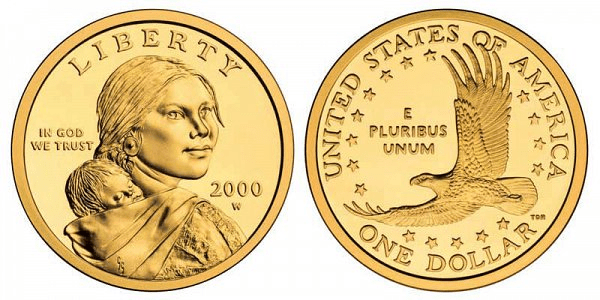
The designs have also changed as part of different current coin programs listed below:
-
Native American One Dollar Coins, First minted in 2000, the Sacagawea dollar motif initially struggled to gain popularity. Since 2009, as part of the Native American $1 Coin Program, its reverse has featured annually changing designs honoring Native American cultures, while the obverse continues to depict Sacagawea and her son, Jean-Baptiste. (2009 to date);
-
Presidential One Dollar Coins, this program showed former U.S. presidents on the obverse and Lady Liberty on the reverse (2007 to date);
-
American Innovation One Dollar Coins features different inventions on the reverse side, while Liberty Motif is on the obverse (2018 to date and planned for 2032).
This article answers the question, "Who is on the dollar coin?" and aims to explore each of the personalities honored by the U.S. Mint from its first release until now.
Circulating Coin vs. Commemorative Coin
The U.S. Mint coins serve two primary purposes: circulating for everyday use, distributed by the Federal Reserve, and commemorative coins for collectors, honoring people, events, or themes.
The U.S. Mint also produces bullion coins made of gold or silver, like the American Silver Eagle, which has a face value of $1 but is worth much more due to its precious metal content.
Dollar Coin Previous Designs
Before its current design, the dollar coin has had a long and diverse history. Various designs have often reflected the sentiments and values of their time. Lady Liberty has consistently been present in these designs, symbolizing freedom and hope.
Today, the coin honors a real person, a Native American woman, representing a significant shift in commemorating history.
Dollar Coin Previous Designs
Flowing Hair Dollar

Source || Flowing Hair Dollar
The Flowing Hair design, featured on the first U.S. silver dollar coins in 1794 and early 1795, the coins show an image of a woman who represented Liberty with flowing hair on the obverse, surrounded by the inscription "LIBERTY" and the year, while the eagle on the reverse is perched on a wreath encircled by "UNITED STATES OF AMERICA."
As the nation's first one-dollar coin, it is highly prized by collectors and remains one of the most valuable silver dollars ever minted.
Draped Bust Dollar

Source || Draped Bust Dollar
The 1795 Draped Bust silver dollar introduced a new design that remained in use until 1804, with business strikes ending in 1803. The obverse features Lady Liberty with flowing hair tied with a ribbon and an intricately draped bust. At the same time, the reverse showcases a bald eagle with outstretched wings, holding an olive branch and arrows to symbolize peace and defense.
Seated Liberty Dollar

Source || Seated Liberty Dollar
The Seated Liberty Silver Dollar, issued from 1836 to 1873, features Miss Liberty seated on a rock, holding a liberty cap on a pole in one hand and a shield inscribed with "LIBERTY" in the other, surrounded by thirteen stars and the date below. The reverse depicts an eagle perched on an olive branch, clutching three arrows, with "UNITED STATES OF AMERICA" above and "ONE DOL." below.
Trade Dollar

Source || Trade Dollar
Introduced in 1873 to compete with the Mexican dollar in international trade, particularly in the Orient, the Trade Dollar features Miss Liberty seated on a bale of merchandise on the obverse, holding a branch in one hand and a ribbon inscribed “LIBERTY” in the other, with wheat behind her, the sea before her, and “IN GOD WE TRUST” above the date.
The reverse depicts an eagle clutching arrows and a branch, surrounded by the inscriptions "UNITED STATES OF AMERICA," "TRADE DOLLAR," and "420 GRAINS, 900 FINE," with the motto “E PLURIBUS UNUM” above.
Morgan Dollar

Source || Morgan Dollar
The Coinage Act of 1873 ended standard silver dollars, replacing them with trade dollars for international use. In 1878, the Bland-Allison Act revived silver dollars as Morgan Silver Dollars, minted from 1878 to 1904 and in 1921 at various U.S. mints, with mint marks (except Philadelphia) on the reverse below the wreath’s bow. The obverse depicts a profile portrait of Liberty, with the inscription "E PLURIBUS UNUM" above her head and the year below. In contrast, the reverse depicts an eagle with outstretched wings, and the inscriptions "UNITED STATES OF AMERICA," "IN GOD WE TRUST," and the denomination "ONE DOLLAR" below it.
Morgan Dollars were continuously minted from 1878 to 1904 and later in 1921. These iconic silver coins were produced at various U.S. mints, including Philadelphia, New Orleans, San Francisco, Denver, and Carson City. With the exception of Philadelphia, all the mints placed mint marks on the reverse of the coins, just below the ribbon bow of the wreath.
However, a significant portion of these coins were not extensively circulated as currency due to their size and weight, which made them less convenient for everyday transactions. Instead, silver certificates were issued and used as a more practical form of currency.
Within the series, there are key dates that hold particular significance to coin collection. Notable examples include the 1889-CC, 1893-S, and 1895 (available only as proof). On the other hand, certain dates like the 1895-O are considered condition-rarities, commonly found in lower grades but exceptionally scarce in higher grades.
Peace Dollar

Source || Peace Dollar
Peace silver dollars, designed by Anthony DeFrancisci and first minted in December 1921, were created to commemorate peace after World War I, an idea proposed by numismatist Farran Zerbe. The obverse features Miss Liberty in profile, wearing a spiked crown reminiscent of the Statue of Liberty, with "LIBERTY" above and "IN GOD WE TRUST" and the date below. The reverse shows an eagle resting on a rock with a laurel branch, the word "PEACE" beneath, and inscriptions including "UNITED STATES OF AMERICA" and "ONE DOLLAR," framed by rays of an unseen sun.
Ike Dollar

Source || Eisenhower Dollar
In 1970, Congress authorized the Eisenhower dollar to honor General Dwight D. Eisenhower and commemorate the 1969 moon landing. In 1971, the Mint released a new version featuring Dwight D. Eisenhower, the 34th president. The dollar was also no longer made of silver. It was a "clad" coin, which means layers of copper and nickel sandwiched an inner layer of pure copper.
The Eisenhower dollar's reverse replicates the Apollo 11 mission insignia, with "UNITED STATES OF AMERICA," "E PLURIBUS UNUM," and the denomination "ONE DOLLAR." The obverse features a left-facing bust of Eisenhower, with the inscriptions "LIBERTY," "IN GOD WE TRUST," and the year below.
Susan B. Anthony Dollar Coin

Source || Susan B. Anthony Dollar Coin
The Susan B. Anthony Dollar, minted from 1979 to 1981 and again in 1999, was the first U.S. coin for everyday use to feature a woman, honoring suffragist Susan B. Anthony. The inscriptions on the obverse go "LIBERTY," "IN GOD WE TRUST," and the year below Susan's Bust. The reverse depicts an American eagle landing on the Moon, adapted from the Apollo 11 insignia used on the Eisenhower Dollar.
Current Dollar Coins Programs
The U.S. Mint continues to celebrate the nation's history and culture through innovative designs honoring individuals, events, and significant themes.
Current Programs
Sacagawea Dollar
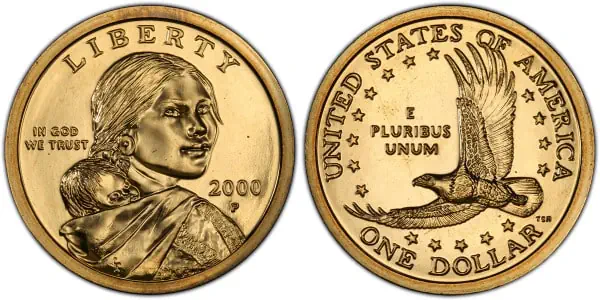
Source: PCGS || Sacagawea Golden Dollar 2000
To honor her significant contributions to the Lewis and Clark expedition and her representation of Native American history and culture, Sacagawea was chosen as the central figure on the Sacagawea dollar coin. Introduced in 2000, also known as "golden dollars," they are not made of gold but consist of an inner layer of pure copper core encased in a manganese-brass alloy, giving them a distinctive golden color.
Golden Dollar's overall composition, according to PCGS:
-
88.5% copper
-
6% zinc
-
3.5% manganese
-
2% nickel
Nowadays, they are marked as native American Dollars, with different designs being released yearly. See below an example of the Native American one dollar uncirculated coin reverse and obverse updated:
Source: USA Coin Book || 2024 Native American Dollar
The obverse of the Golden Dollar features Sacagawea in a three-quarter profile, gazing directly at us. Her infant son, the baby Jean Baptiste, is secured on her back with a drape. Above her head is the inscription "LIBERTY," with "IN GOD WE TRUST" on the left and the mint year on the right. Artist Glenna Goodacre captured Sacagawea's essence by emphasizing her large, dark eyes, inspired by Shoshone legends. To create this iconic depiction of Sacagawea carrying her baby Jean, Goodacre used Randy'L He-dow Teton, a Shoshone college student, as her model.
The reverse complements the Native American Dollar obverse with profound symbolism. It features the American flag and the Eagle Staff. The Eagle Staff, often considered the first flag of the Americas, represents tribal achievements, integrity, and sovereignty. It also pays respect to the Native American and First Nations communities and the Indian Citizenship Act of 1924. Surrounding the design are the inscriptions "UNITED STATES OF AMERICA," "$1," and "INDIAN CITIZENSHIP ACT OF 1924."
The obverse forms one of the most symbolic and meaningful coin designs ever minted. At the same time, its reverse highlights important Native Americans symbols, linking past and present.
The Native American Dollars
In 2009, the U.S. Mint initiated the production and release of dollar coins as part of the Native American One Dollar Coin Program. These coins showcase reverse designs that honor the significant contributions of Native American tribes and individuals to the history and growth of the United States.
This new dollar coin series builds upon the foundation of the Sacagawea Golden Dollar, which was previously introduced in 2000.

Source: USA Coin Book || Native American Dollars (2009-Present)
The Secretary of the Treasury chooses the reverse designs for the Native American One Dollar Coin in consultation with the U.S. Senate Committee on Indian Affairs, the Congressional Native American Caucus of the U.S. House of Representatives, the Commission of Fine Arts, and the National Congress of American Indians.
The Citizens Coinage Advisory Committee also reviews the designs with input from the public.
Like Presidential One Dollar Coins, Native American One Dollar Coins have a unique smooth edge, are golden coins in color, and include edge-lettering of the year, mint mark, and the motto E PLURIBUS UNUM.
American Innovation Dollar Coins
Another dollar coin program is the American Innovation $1 Coins. The program honors innovators from each U.S. state, the District of Columbia, and five territories, with four new coin designs released each year from 2019 to 2032. The obverse features Lady Liberty, while the reverse design changes annually. The composition of the coin is the same as the previous series.
See below the American innovation Dollar uncirculated coin obverse and reverse:
Source: USA Coin Book || Steel Plow - Illinois
Source: USA Book Coin || Saturn V - Alabama
Source: USA Book Coin || Direct Current Defibrillator - Maine
Source: USA Book Coin || George Washington Carver - Missouri
Each year, four reverse designs celebrate an invention made in each state. After all states are represented, coins will honor the District of Columbia and territories. These legal tender coins are produced in limited numbers and are available quickly.
Presidential Dollars
In 2007, the U.S. Mint launched the Presidential Dollar Coin Program, issuing four coins per year honoring presidents in order of service. From 2007 to 2016, coins featured presidential profiles on the obverse and the Statue of Liberty on the reverse.
Most Recently Issued Presidential Dollar Coins
George H.W. Bush (1989–1993)
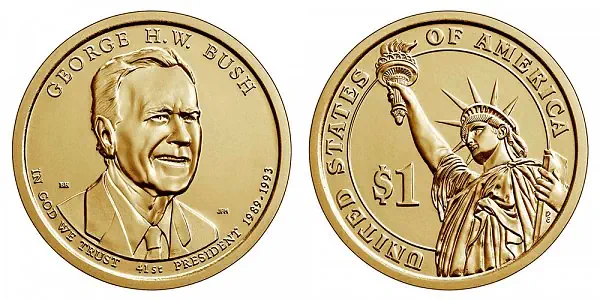 Source: USA Coinbook || 2020 P Presidential Dollars: George H.W. Bush
Source: USA Coinbook || 2020 P Presidential Dollars: George H.W. Bush
Ronald Reagan (1981–1989)
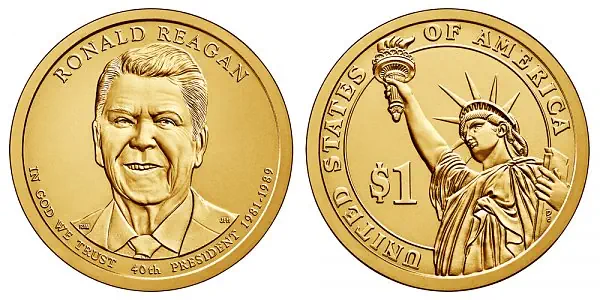 Source: USA Coinbook || 2016 P Presidential Dollars: Ronald Reagan
Source: USA Coinbook || 2016 P Presidential Dollars: Ronald Reagan
Gerald R. Ford (1974–1977)
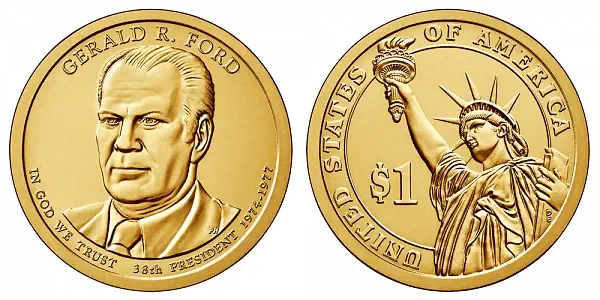 Source: USA Coinbook || 2016 P Presidential Dollars: Gerald R. Ford
Source: USA Coinbook || 2016 P Presidential Dollars: Gerald R. Ford
Richard M. Nixon (1969–1974)
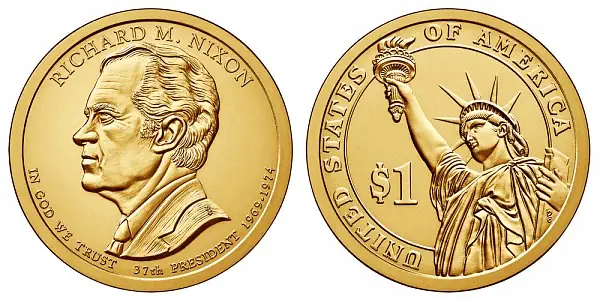 Source: USA Coinbook || 2016 P Presidential Dollars: Richard M. Nixon
Source: USA Coinbook || 2016 P Presidential Dollars: Richard M. Nixon
According to the Presidential Dollar Coin Program rules, a US President can only be honored in the series if they have been deceased for no less than two years. Some recent presidents are still alive and would not yet qualify to be depicted on the coinage.
Modern Morgan And Peace Silver Dollars
In 2021, the US Mint released a revamped .999 fine silver version of the classic Morgan and Peace Dollars. These Modern Silver Dollars are intended for collectors and bullion investors. They come in an original mint box accompanied by a Certificate of Authenticity. The restrikes were so popular that new mintages were released in 2023 and 2024.
Final Thoughts
Throughout centuries, the dollar coin has featured a plethora of personalities on the dollar coin allowing us to appreciate the nation's heritage, its currency's evolution, and its significant role in society. By studying coins, we uncover the narratives of the past and gain a deeper understanding of our collective identity as a nation.
Who is the person on the 1 dollar coin?
The person featured on the 1 dollar coin is a Native American woman, Sacagawea, carrying her baby. She served as an interpreter and guide for the Lewis and Clark Expedition, a journey to explore the wild western U.S. The Native American Dollar reverse depicts an eagle staff, imagery used to celebrate the 100th anniversary of the Indian Citizenship Act of 1924, which granted U.S. citizenship to Indigenous people born there. This design is part of the native American one-dollar coins.
Which U.S. presidents are featured on dollar coins?
The presidential dollar series honors U.S. presidents in the chronological order they served. The most recent releases are George H.W. Bush in 2020, Ronald Reagan, Gerald R. Ford, and Richard M. Nixon in 2016. Under the Presidential Dollar Coin Program, a U.S. president must be deceased for at least two years to qualify for depiction, excluding some recent still alive presidents.
What is the difference between a Sacagawea dollar and a Presidential dollar coin?
They are from different coin programs. The Presidential Dollar series was a program by the U.S. Mint that aimed to honor American presidents by featuring them on the 1 Dollar coin. The U.S. Mint released the Sacagawea Golden Dollar 2000 project, now part of the Native American Dollar series. The reverse highlights an important native contribution to the country's history, depicting an eagle staff, and the obverse pays tribute to an important historical figure of a Native American woman called Sacagawea, carrying her baby Jean-Baptiste on the obverse.
How can I tell if my dollar coin is valuable?
Every dollar coin minted by the United States Mint, which is responsible for producing American coinage, is worth at least its face value of one dollar. However, rare dollar coins can have a significantly higher value. Collectors should look for unique features such as minting errors, double strikes, distinctive details, or overdates. To determine if a coin is rare, it is best to appraise it by a numismatic professional such as an experienced coin dealer. Some rare and valuable U.S. dollar coins include the 1974 Flowing Hair Dollar, the 1804 Dollar, the 1885 Trade Dollar, the Morgan Silver Dollar, and the 1870-S Seated Liberty Dollar.
How are dollar coins different from dollar bills?
Dollar coins and bills differ primarily in composition, physical properties, and lifespan. Coins are made of metals, sometimes including precious metals, while American bills consist of 25% linen and 75% cotton. The form of paper money is lighter, more compact, and less durable over time, with an average lifespan of about 6 years, depending on circulation. In contrast, coins can last decades or even centuries, though they are bulkier. Coins made from precious metals, such as gold or silver, often have a value exceeding their face amount due to their intrinsic metal content. These are known as bullion coins and are primarily used for investment purposes.
Are dollar coins made of silver?
No. Silver coins have not been produced in the United States since 1971. However, from 1794 to 1935, the U.S. Mint issued dollar coins made of 90% silver content. Though these silver dollars are still legal tender, they are mostly traded based on their intrinsic value (precious metal content), intended for investment or collection, rather than used in everyday transactions. Currently, the dollar coin in circulation is composed of copper and nickel metals, with a carefully balanced mix of manganese zinc contributing to its durability and distinctive appearance.


















